Everything Electric: Why A Clean Future Requires Electric Cars and More
12 minute read
Updated on: 03 Mar 2021
What do phones, refrigerators, and TVs have in common? They use energy in the form of electricity.
Why do we want to make (almost) everything electric? Because clean Nuclear reactors, solar panels and wind turbines all produce electricity. To use this clean electricity, we need to be able to power transportation and heating with electricity rather than oil or gas.
As a side note, turning mobile emissions (e.g. from cars) into stationary ones (from power plants) makes using carbon capture a lot easier too. But more about that in our "Industrial Innovation" course!
Converting electricity to heat has nearly 100% efficiency. The only thing stopping us is the incredibly low price of gas
. Therefore, we need to make clean electricity cheaper. Keep in mind that there’s no point in using electricity instead of gas if the electricity comes from fossil fuels
.
So what about transport?
Batteries could replace 71% of transport fuels!
But what about cars, trucks, busses, etc? Electric cars already exist and, with some improvements in battery performance and lifetime, electric trucks are also within reach
. Luckily, this kind of land transport makes up the majority of all transport emissions
.
Improving battery performance, lifetime, and cost is at the heart of the transition to electric transport. If this sounds interesting to you, read on! We’ll discuss in quite some detail how today’s batteries work and then go into how they could be improved.
What are batteries?
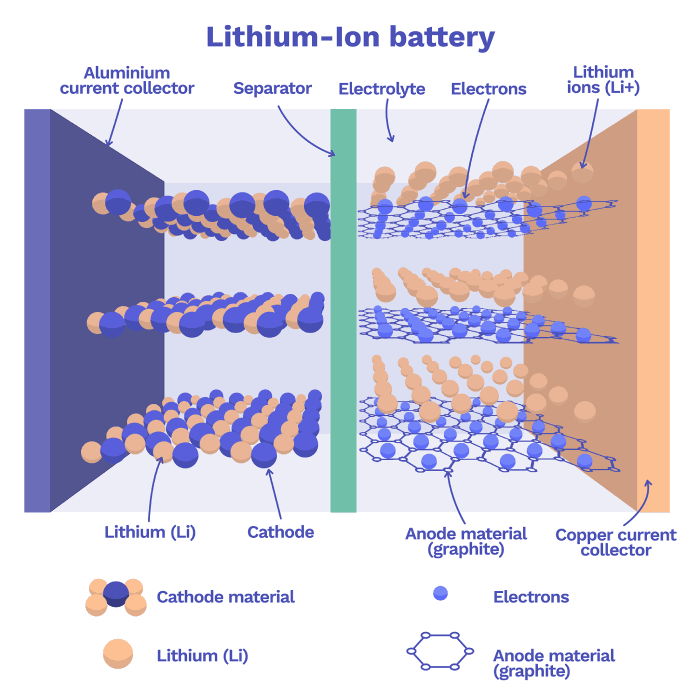
Lithium-Ion battery
There are many kinds of battery chemistries, but they mostly consist of components fulfilling the same fundamental roles:
- Lithium atoms, each of which can lose an electron to become a positive lithium ion (that’s where the word “Lithium-Ion battery” comes from!)
.
- The Cathode - a material that attracts lithium (this is the positive side of the battery)
.
- The Anode - a material that can store lithium ions and electrons, usually a material called graphite
(this is the negative side of the battery)
.
- The Separator - a wall between the cathode and anode. Lithium ions can pass through it, but electrons are blocked
.
- The Electrolyte - the material that the cathode and anode are placed in. This has no charge so it doesn’t interact with the rest of the battery, and can be liquid or solid
.
Let’s look at this in more detail.
How does charging work?
In summary, charging involves using energy to force lithium from the positive cathode into the negative anode.
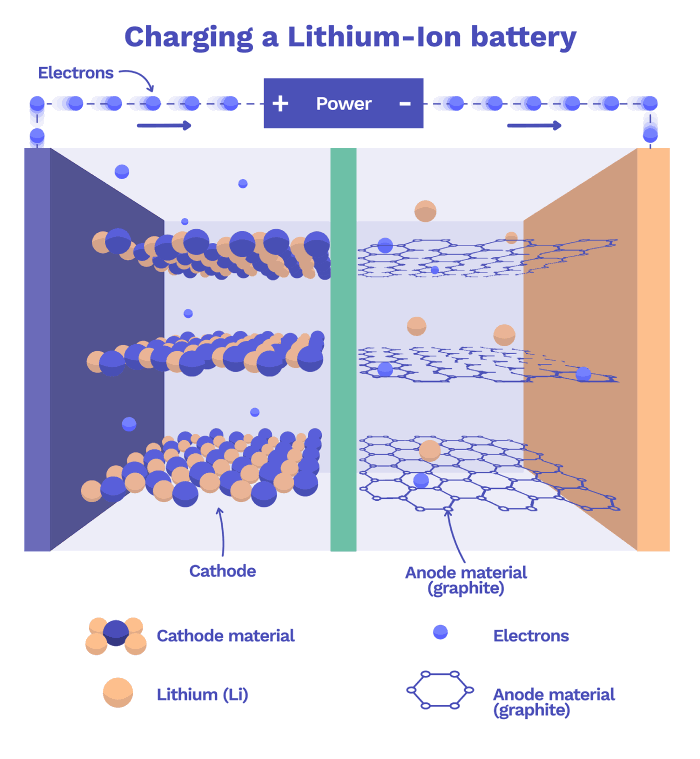
Charging a Lithium-Ion battery
When an empty battery is connected to another power source, an electron will be ripped off each lithium atom and start flowing through the power source from the cathode to the anode.
When an electron is ripped away from lithium, it leaves behind positively charged lithium ions. These positively charged ions are attracted to the now negatively charged anode, containing the electrons. Consequently, the ions flow through the separator into the anode.
The graphite in the anode then acts like bread in a sandwich, keeping the lithium ions and electrons separated between its layers until the battery is discharged. This is an unstable state - lithium ions really want to be combined with their electrons.
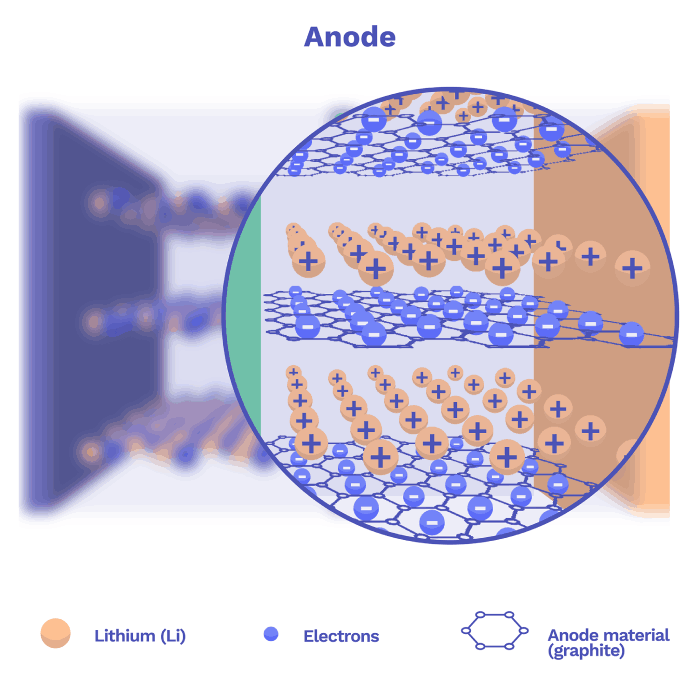
Anode
How does discharging work?
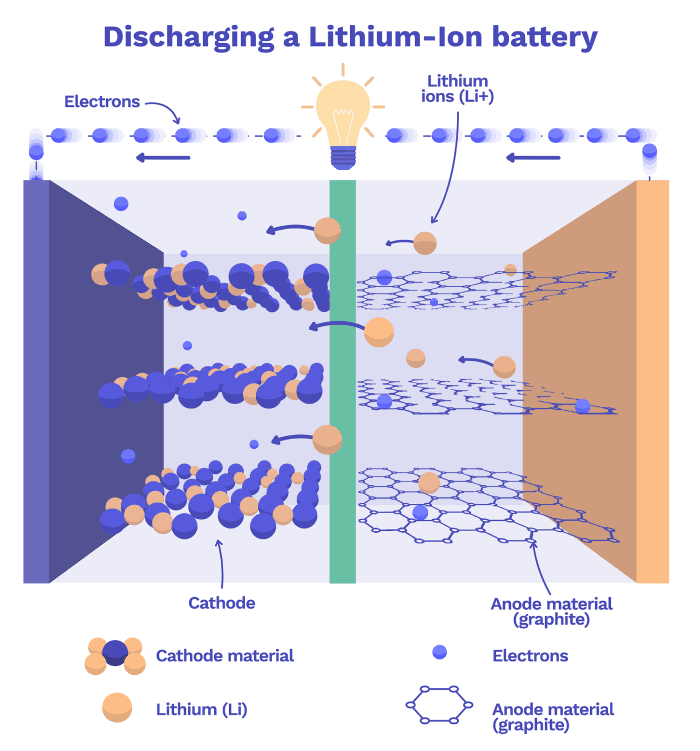
Discharging a Lithium-Ion battery
When the anode and cathode are connected via a cable, the lithium ions flow back through the separator, while the electrons take the path back through the external circuit. In the cathode, they recombine and return to a stable state
.
When the electrons flow back through the cable, they create an electric current. This current can be used to power a lightbulb, your phone, or other devices!
Why lithium?
Out of all the elements we know, lithium is one of the most willing to give away electrons. Other materials are relatively more willing to take electrons instead. This is largely due to their electron configurations.
Why? Atoms are made of a core (called a nucleus) and electrons. The electrons surround the core in electron shells. Atoms want their shells to be “full”. They are even ready to share their electrons with other atoms to make this happen. This rule is at the heart of batteries.
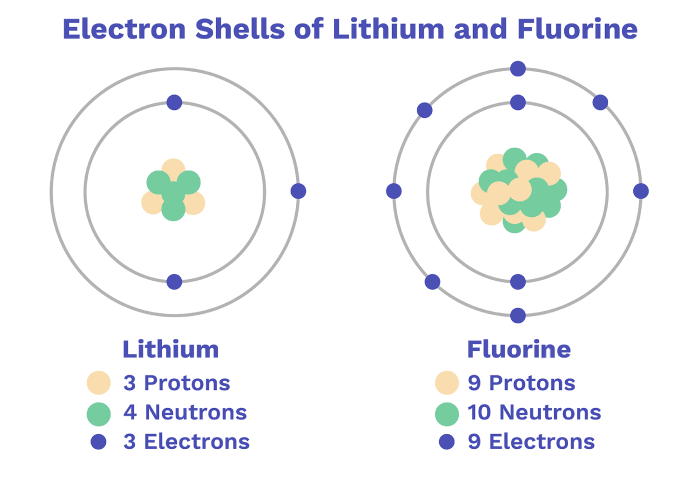
Electron shells of Lithium and Fluoride
For fluorine, it’s easier to add one electron than give away seven electrons. For lithium, it’s easier to give one away.
Can we improve batteries?
As we’ve said, electric cars are already commercially available and useful. However, they are still relatively expensive and it’s always good to have performance improvements
. Trucks are close to reality, but electric airplanes and ships are unlikely to be used with today’s battery technology
. Could we make these possible too?
Some key aspects we would really like to improve in batteries are:
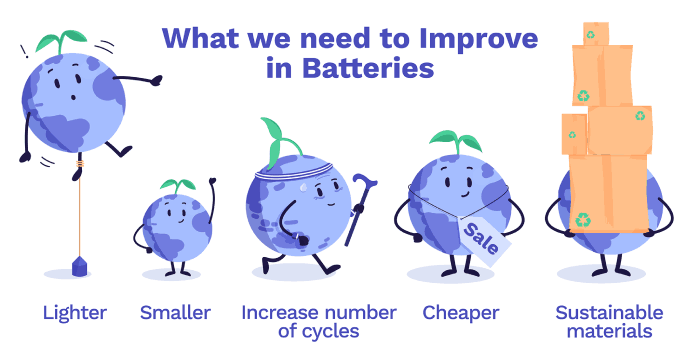
Improving batteries
Most technologies have a physical limit. For example, commercial solar panels today absorb 20% of the sunlight that hit them. Theoretically, we might be able to build solar panels that harvest 100% of the sunlight hitting them, but clearly never more than 100%. This is a theoretical limit.
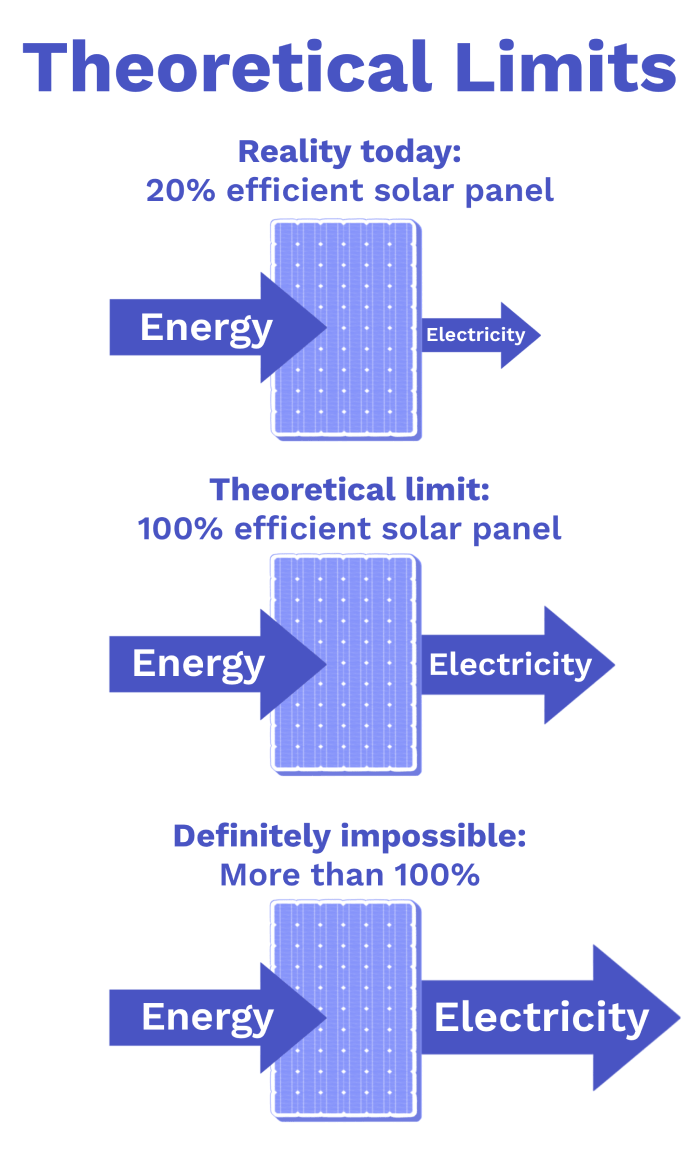
Theoretical limits
Increasing the number of charge cycles a battery survives has no obvious theoretical limit. And in reality? Batteries today survive thousands of cycles, but recent research could increase this by a factor of 2 to 3
. Exciting times ahead!
But what about their weight and size?
Lighter and smaller batteries?
Modern batteries can fit around 250Wh of energy into 1kg of battery. For comparison, fuels like diesel or kerosene can hold 13,000Wh/kg
!
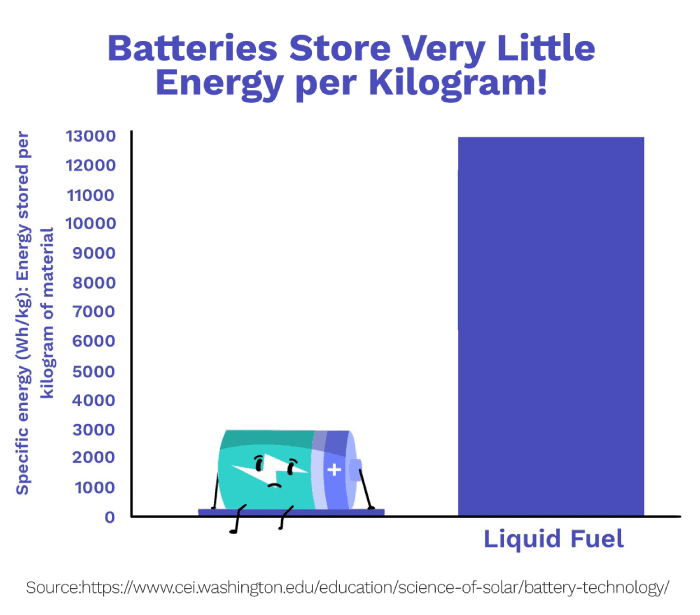
Battery vs Liquid fuel
How can we improve this? Let’s start with theoretical limits to see if any realistic effort is worth it. We can’t aim higher than the absolute best outcome, so this is always a good first step!
The first thing to look at is how heavy each component of a battery is:
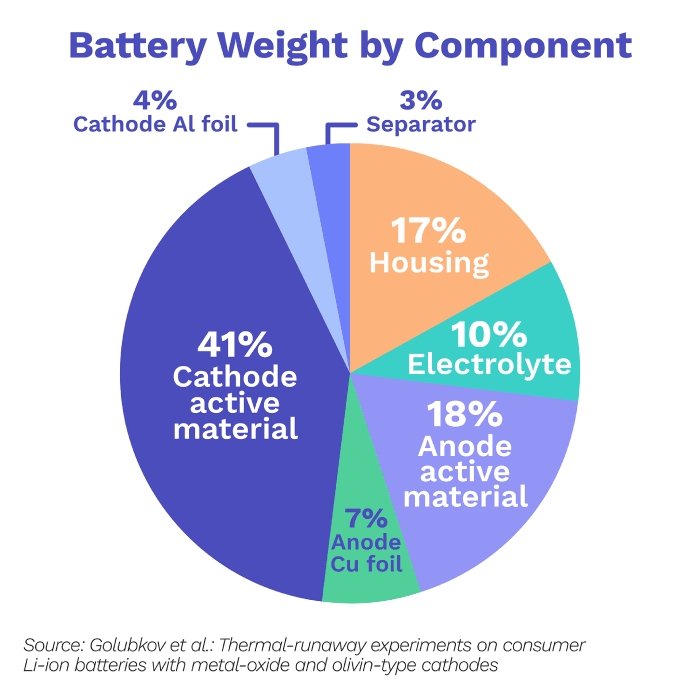
Battery weight by component
Step 1: Let’s ditch all of the ‘unnecessary’ stuff. Everything apart from the cathode and the anode is just there to help - in the real world we need it, but in theory we don’t. Note that the weight of lithium is included in the weight of the cathode and anode.
We need to collect the lithium somewhere, but that’s about all the anode is there for. There are ways of doing that without an anode .
If we could build a battery without the supporting parts and a weightless anode, we could cut the weight down to 41% of what today’s batteries weigh, giving us a specific energy of 250/0.41 = 609Wh/kg.
What’s the best cathode possible?
We want to choose materials that have minimum weight and a strong attraction to lithium.
Here are a few materials that are being explored as options for lighter cathodes, together with their theoretical maximum specific energy:

Specific Energy of battery types and gasoline
It looks like Lithium-O₂ could make batteries as light as gasoline!
Is Li-S & Li-O₂ actually possible?
The most common type of cathode used today is Lithium Cobalt Oxide (LiCoO₂). It’s quite heavy, but it works. By contrast, the ’better’ alternatives we talk about here are still being developed
.
Lithium-Sulfur batteries are already out there too, but not yet at massive scale.
Lithium-O₂ batteries are trickier than Li-S batteries, but they are possible. We just don’t know yet if we can make them work well enough to be practically useful
.
The real dealbreaker, however, is that we have been talking about theoretical numbers. As you recall, we ditched all components other than the cathode. The cathode only made up 41% of the total mass, so even if we reach the theoretical minimum of cathode mass, the other 59% of today’s battery mass would still be there. This means we’d get less than a 2x improvement even if the cathode weighed nothing!
Ouch! Research is hard, but with a lot of brainpower (and investment), these technologies are getting better step by step! Anodes and the materials that hold batteries together are getting lighter too, and researchers are making progress all the time
.
The main conclusion from this is: we may never have batteries with the same specific energy as gasoline, but we could get batteries that hold more than twice, maybe even 3 to 5 times as much energy per kg as today’s batteries.
How to make electric cars and trucks cheap
The price of lithium-ion batteries has been falling dramatically in recent years, and is predicted to fall even further.
This is partially due to innovation, but also due to scale. Today, we are building way more batteries than a few years ago, and that allows the industry to use mass production methods that make the whole process cheaper
. The company Tesla, one of the biggest battery producers in the world, is building enormous factories to increase automation and output and decrease cost.
Can we use batteries to solve solar’s and wind’s storage problem?
For electric transportation, energy density and specific energy matter a lot. However, for grid-scale storage, scalability and cost are much more important. Why? Because we need to store a lot of energy. Let’s look at the numbers.
We’d love to see a lower number here, but sadly this is where we are at. US$70 trillion is more than 80% of the total world GDP of 2018. That means, building enough batteries to hold one day’s worth of electricity for the whole globe would cost 80% as much as all the goods produced in 2018 - all of them!
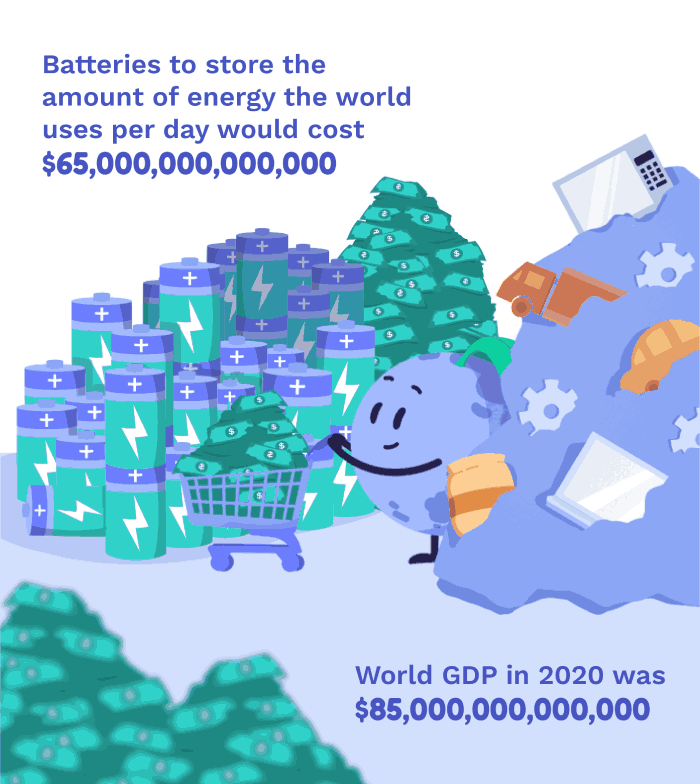
Today’s batteries are expensive
Batteries are extremely important for the electrification of transportation, so what you’ve learned here is still very useful.
But we haven’t given up on large-scale storage yet! We will look at a few energy storage alternatives in two chapters time. But first, let’s take a look at hydrogen fuel and explore how it could electrify airplanes and ships, and maybe be an alternative to batteries in cars.
Next Chapter

